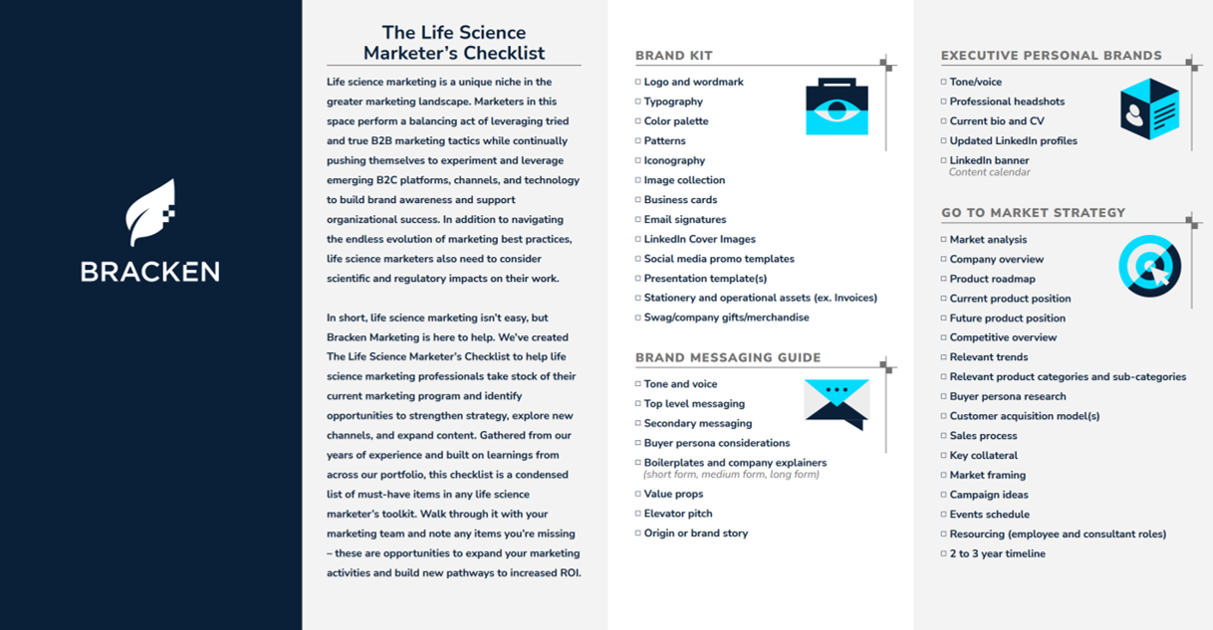4 Core Considerations for Life Science Marketing
Sasha Reanier
Just take marketing and make it life science—easy, right? If only it were so. Marketing development, deployment, and strategy is complex in and of itself. Finding the right approach for the highly technical field of life science comes with additional requisites few marketing teams even attempt to navigate. In this article, we’ll offer tips, resources (like a handy marketer’s checklist), and delve into the expertise needed to market successfully in the life science industry.
Know what you have—know what you need
There’s no getting around the fact that life science marketing is challenging. In addition to standard marketing best practices, the niche field of life science deals with highly technical products, scientific concepts, and regulatory processes. Balancing all these elements requires a great deal of organization and expertise in the industry itself.
A robust marketing strategy is key to building brand equity and an effective, efficient sales pipeline—the overall goal. And the best way to develop that all-important strategy is to take stock of where you’re at and assess your resources. To aid in this self-assessment, we’ve developed The Life Science Marketer’s Checklist of must-haves for marketing professionals in the industry. This tool is designed to help you see your areas of strength and pinpoint areas you may have overlooked or have room for improvement.
After taking stock and highlighting areas in your marketing package that aren’t being actively cultivated, you may find the reason for this is lack of sufficient resources. Use this information to decide where to best place your assets to get the most bang for your buck. Instead of trying to cover all bases with less, which will lead to lower-quality service across the board, play to your strengths and use the resources you have to support execution of your best categories. It’s far better to do a few things excellently than settle for mediocrity.
1. No matter your strategy, alignment is key
When it comes to developing and implementing a marketing strategy, think like a chiropractor and align, align, align! While you will certainly implement and try different marketing techniques, whatever new tactics you devise need to maintain message continuity. One campaign cannot be in direct contrast with another.
It’s also imperative for your sales and marketing team to be on the same page as your services and products team. Maintaining constant communication will ensure you aren’t selling ahead of your product roadmap. Furthermore, it’s important for everyone within your organization to understand who your buyers are. Once everyone recognizes this, better promotional and content strategies will develop from there.
After the target audience is established, the marketing team can focus on building relationships with the audience that will develop and grow their long-term investment with the company. Priming them mentally for products and features that are yet to come will drive interest when those new offerings are ready for sale. Again, for this strategy to work effectively, it takes overall alignment across teams.
2. Know your brand, be your brand
Focusing on brand identity and messaging is one of the best ways to build a clear identity and establish an immediately recognizable presence in industry spaces. Your brand tells a story, both visually and with the words you choose. Making that story cohesive across all elements is an important part of communicating who you are and what you represent. Establishing guidelines that everyone on your team follows regarding diction and visual elements will help maintain one coordinated message, further strengthening your brand. When demonstrating your brand, consider the following:
-
Anyone should be able to look at your business cards, sales call talk tracks, website, sales decks, etc., and know that they came from the same company and represent the same brand.
-
What is most important for your brand to represent?
-
If you want to communicate ease of doing business, have a clean style with uncomplicated messaging. Furthermore, consider how additional elements can represent this by having a simple website navigation, etc.
-
-
-
If you want to communicate high-science concepts, focus on credibility building, precise language, and accurate visuals.
-
-
The personal brand of your executives should still reflect your overall company. Usually, an executive’s LinkedIn post is going to have a greater reach than that of the company. With united visuals and messaging, executives can leverage their wider networks to help uphold the company’s brand.
-
3. Amplify with digital marketing, press, and advertising
While the needs of each brand are different, on the whole, this is the area we recommend spending the bulk of your marketing budget. (The other area we recommend is events, which has a high ROI for life science firms.) Digital marketing is a highly effective way of generating website traffic and new leads. The success of many digital marketing channels compound upon one another, increasing success across platforms. For example: when distributed correctly, strong web content will boost performance across SEO, social media, and email newsletters.
These days, digital marketing goes hand-in-hand with press, as press releases get indexed by Google for SEO and perform well on LinkedIn as part of a social media strategy. Press releases are an important vehicle to advertise major announcements and upcoming events. It can be particularly attention grabbing when an executive highlights these announcements on LinkedIn. Take a look at your upcoming calendar year and flag a few events, launches, or announcements that can be turned into press releases.
To add fuel to your marketing fire, add advertising. Start small—this will help inform how to get your best CPL (cost per lead) or performance-based unit economics out of your advertising budget. After you’ve figured out what performs best on a small scale, pour in more of your budget. LinkedIn is particularly strong for B2B life science organizations, but it can prove expensive, so be sure you have the numbers worked out before diving in.
When it comes to Bracken’s clients, paid media placements are top performers. This is supported by the fact that Bracken has pre-existing relationships with many field-specific media outlets within the industry. Establishing such connections can help get content promoted through these advantageous channels for a fee.
-
4. Grow what you have: Customer marketing and sales enablement
An essential, and often overlooked, component of best marketing practice is about driving revenue growth by utilizing those who are already in communication with or affiliated with your business. For example: you might go above and beyond by giving existing customers helpful collateral that would traditionally be used as marketing collateral.
Coming up with ways that improve your sales or customer success process will go a long way toward building positive relationships with existing contacts and customers that end up extending and expanding. In some cases, there is more revenue opportunity for your business in upselling or cross-selling existing leads and customers than there is in trying to generate net new leads.

Fortify your team with Bracken
Life science isn’t the kind of industry where you can “fake it till you make it.” At Bracken, our industry experts are here to address any questions you may have about marketing in the life science field. We’re ready to help you meet your goals by consulting with, supplementing, or being your marketing team.
Schedule a meeting with our experts via this link.




